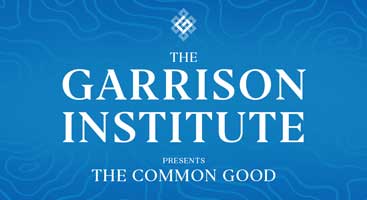In this illuminating conversation, science writer and Biomimicry Institute co-founder Janine Benyus joins Jonathan F.P. Rose to explore nature’s universals—the deep design patterns that guide all living systems. Benyus, known worldwide for pioneering biomimicry, reveals how life creates the conditions conducive to life through cooperation, self-organization, and elegant networked intelligence. From coral reefs and forests to economic and social systems, she shows how natural principles such as right-sizing and distributed abundance can guide human innovation and ethics. Together, they examine how re-embracing our biological literacy can reshape industry, culture, and Western spirituality—inviting us to see the world not as a collection of parts, but as a living, interdependent whole.

Host
The Garrison Institute co-founder, urban visionary and award-winning author Jonathan F.P. Rose.
Guest
Janine Benyus is a pioneering science writer, naturalist, and innovation consultant best known for introducing the world to biomimicry—the practice of learning from and emulating nature’s strategies to solve human challenges sustainably. As the co-founder of the Biomimicry Institute and Biomimicry 3.8, she has helped organizations, designers, and communities apply nature’s principles of resilience, adaptability, and regeneration to real-world problems.
Transcript
Read and download full transcript
Related Resources
- Janine Benyus official page at the Biomimicry Institute
- The Biomimicry Institute website
- Janine’s landmark book, Biomimicry: Innovation Inspired By Nature
- Biomimicry 3.8: the nature‑positive design consultancy co‑founded by Janine, working with companies and systems.
- The Biomimicry Center at Arizona State University: academic hub for biomimicry education and research.
You May Also Be Interested In…
- PARTICIPATE: Living the Hero’s Journey: Discovering Who We Truly Are | 2-3:30 ET; November 18, 2025 | Virtual
- ENGAGE: Pathways to Planetary Health Initiative develops scalable solutions to urgent social and environmental challenges
- READ: Finding Awe in Nature by Stephen Posner in conversation with Kim Nolan
- WATCH: Dr. Bayo Akomolafe: Wrestling With Post-Activism & Planetary Health
More Episodes
Show Notes
00:50 – 01:02 — Host Jonathan FP Rose introduces guest Janine Benyus, biologist, author and co‑founder of the Biomimicry Institute. Her work has reframed how businesses, scientists and communities approach design — shifting from extraction to regeneration, and from competition to collaboration.
01:02 – 05:25 — Janine recounts her childhood in suburban New Jersey: exploring a ravine and meadow near home, observing insects and nesting birds like a “neighbourhood” of organisms; experimenting with microscopes; then witnessing development bulldozers roll through habitat and vowing to tell the animals’ stories.
05:25 – 08:17 — The genesis of the word “biomimicry”: Janine explains how she collected xeroxed research papers in the early 1990s, looked up the Greek roots (“bio” + “mimesis”), and wrote the term on a file drawer, signalling a field without a name.
08:17 – 10:10 — Examples of biomimicry in action: the scalloped leading edge of a humpback whale fin inspiring wind turbine blades; a system in India mimicking plant‑communication chemistry to extend the shelf life of fruit and vegetables by mimicking nature’s signalling processes.
10:10 – 16:01 — System‑level biomimicry: Janine describes how entire cities, buildings and districts can be designed to function like ecosystems. She introduces “ecological performance indicators” (e.g., water storage, carbon sequestration, cooling, habitat support, erosion control) by measuring a nearby intact ecosystem and applying that to built‑sites.
16:01 – 19:34 — The phrase “life creates conditions conducive to life” emerges: Janine explains how ecosystems rebound from disturbance and improve their fertility over time, and how this shifts the design brief from “What’s good for us?” to “What’s good for all life?”
21:17 – 24:44 — Deepening the worldview: The concept of “con-biotic” is introduced, emphasizing that the planet is a living co‑evolved system. Jonathan and Janine point to how indigenous societies long held this view. A universal ethical guide: Does this create the conditions conducive to life?
24:44 – 32:53 — How nature grows, right‐sizes, and distributes: Janine explains how nature does not indefinitely grow in size but develops complexity and efficient distribution (e.g., vascular networks, fungal networks, economic analogues).
32:53 –42:02 — Re‑organising after crisis: The “adaptive cycle” of growth‑release‑reorganisation is discussed, and how places freed from entrenched global systems (e.g., de‑industrialised regions) may become islands of coherence and regeneration.
42:02 – 47:02 — Collective healing and stress‑gradient hypothesis: Trauma is not healed alone but in community; in harsher conditions organisms cooperate. This has analogies in human systems and ecosystems.
47:02 – 51:45 — Self‑organization, networks and integration: The concept that cells, organisms and ecosystems are collective “selves” is explored. Language matters: shifting from atomistic “self” to flow/process‑oriented “we”.
51:45 – 55:28 — Unity in diversity: Janine reflects on deep biological patterns that underlie all life, from molecules to ecosystems, and the spiritual dimension of realizing “we are not separate from them”.
55:28 – 56:45 — Closing remarks: Jonathan and Janine speak about the shared responsibility to create conditions conducive to life. Janine calls for becoming good citizens of the earth and reconnecting with the living world.




